
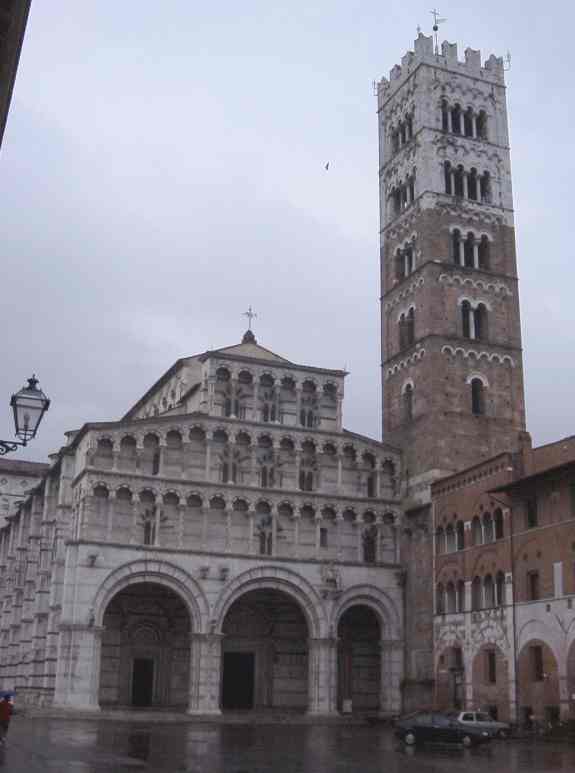
Lucca was wet! Up to the last day of our 6 day trip we had pretty much worked around the rains, dodging inside or under umbrellas while the November Tuscan weather temporarily misted the area but scared most other tourists away. But on the 6th day, the downpour bested us. By lunchtime we were soaked through and beat a slightly early retreat to the airport.
But before we drowned, we saw some of Lucca, a remarkably well contained town behind its recent (1550-1650) well preserved walls. (These 40 foot wide structures have extensive rooms below; however, they never had to defend the city from human attackers but did keep 1812 flood out). There are, in fact, four sets of walls going all the way back to the tiny Roman city.
Unlike most Tuscan cities obsessed with their primacy during Gothic or Renaissance times, Lucca does not hide its Roman past. Here Pompey, Crassus, and Caesar met as part of the first (and secret) Triumvirate in 56 BC. (Did these guys have a Year 0000 date problem or were there no IS consultants to hype the issue then? People have lived on the Luccan plains for 50,000 years so their DNA has probably not had any century end problems the last 500 times or so.)
We started our Monday with an early morning jog/walk along the beach (lined with expensive retail stores) in Viareggio. After breakfast we checked out of the delightful President's hotel and took the A11 superhighway east, past the Apennine mountains with their caves and all that marble Michelangelo left behind. Within minutes we drove right through 40 foot wide city walls into Lucca, the dominant city of Tuscany towards the end of the first millenium before falling under Florence's and Pisa's sway.
Finding a parking place in the rain was pretty easy and we were soon greeted by a Luccan cop whose only job seemed to be watching our car and collecting the pittance of a fee before we left. Apparently all those city walls keep out the riff raff and so she didn't have much to do.
Soon we were at our first destination -- what else, the cathedral. St. Martin's is pictured at the top of the page. Notice the square bell tower -- quite typical here. Notice how each level successively increases in the number of windows as the tower rises; one way to decrease the weight of the rising tower. There's been a church on this spot since the 6th century but what the picture captured is probably 11th century. I hope to look this good after 1000 years even if I'm not, like this church, symmetrical. (Hard to say why they didn't plan those arches better since the bell tower was already there.) The three porches (Pisan-like loggias) are 14th century.
Here's a close-up of the details under the central door showing Christ's ascension between two angels with Mary and the apostles lined up stiffly below.
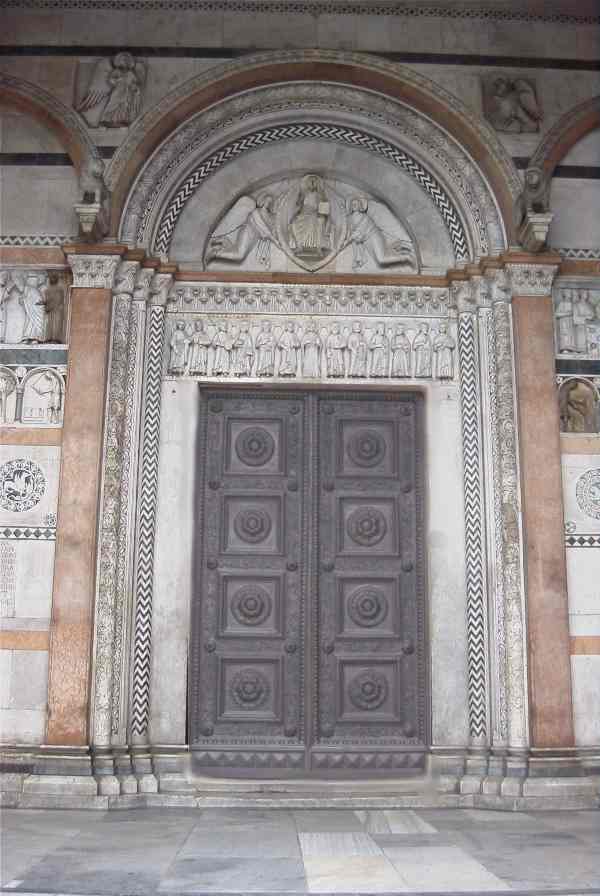
Much goes on inside the Cathedral including a great Sarcophagus by Jacopo della Quercia (fountain guy in Siena, remember?) in 1405 (pictures forbidden but by clicking here you can see a close up.) We were able to get the Last Supper painting by the Venetian Tintoretto. The angel in the lower right corner seems to have his own ideas:
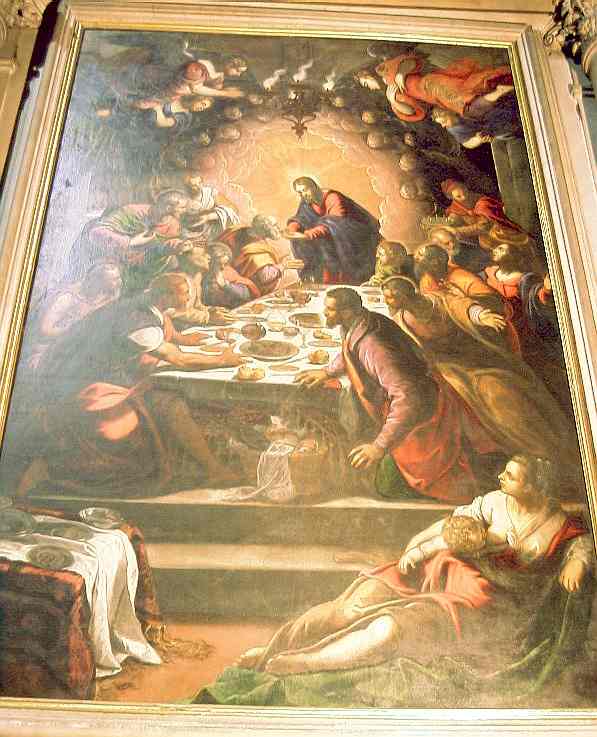
There are lots of churches in Lucca including one right next door to the cathedral called Chiesa e Battistero di San Giovanni. In fact, it is five layers of churches going all the way back to a Roman temple. School kids were jamming the entrance when we were there so we thought we'd skip the subterranean tour this time.
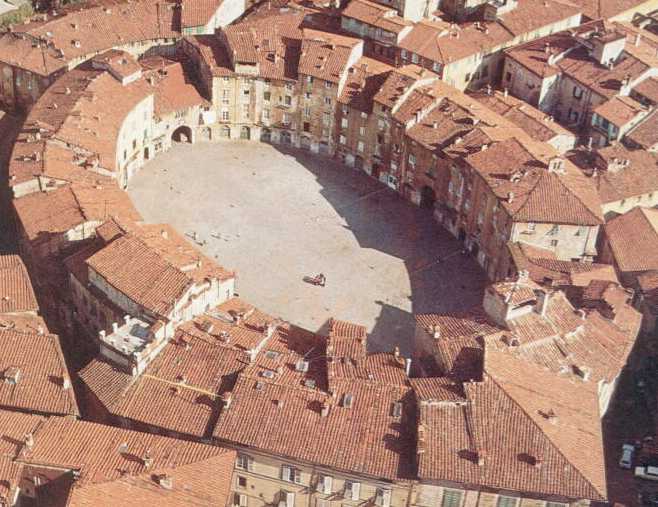
But our next stop was appropriately Roman as we traveled down the narrow, but well marked, streets to see the empty space that was once the first century AD Roman Amphitheater. (This is a pretty good tourist trap trick getting folks to travel to see what is no longer there.) The picture above shows the aerial view in the shape of an oval coliseum. When the Christian bishops were trying to stamp out pagan influences, the Luccans most probably tore down their amphitheater that held 10,000 people and probably fewer lions. (Yes, the old Italians were even worse about taking care of this stuff than the moderns, maybe no Japanese cameras back then?) As time went on, the Luccans piled buildings on top of the space until the Duke of Lucca had the space retrieved during the early 19th century. (The ruins lie about 10 feet below the plaza). Here's a street level view with one soggy chick:

About a block from amphitheater is the Basilica San Frediano. Here's a close up:
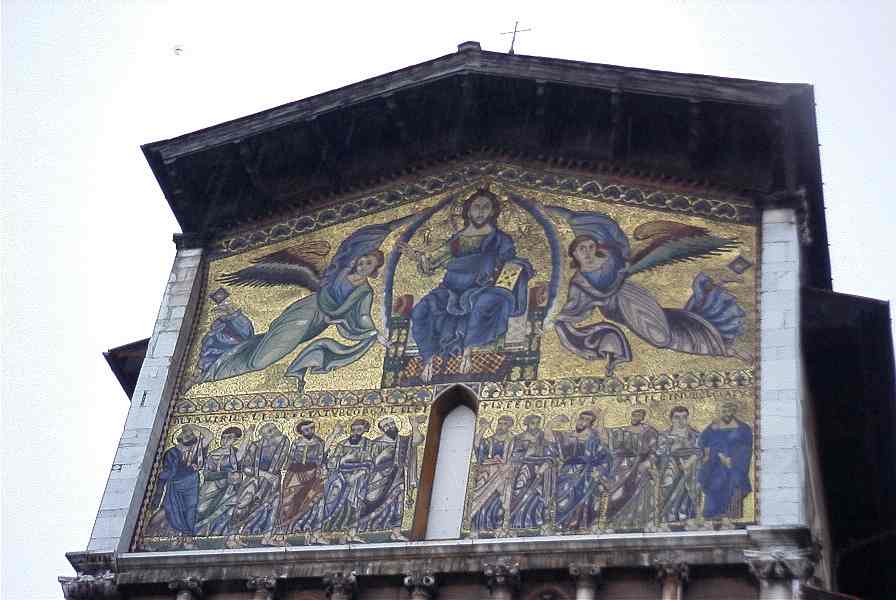
Frediano was the 6th century Irish bishop who may have ordered the Amphitheater torn down and the stones used for other purposes, possibly for the original church on this spot. What we're seeing is a 13th century mosaic of Christ ascending between two angels (again!) This gold mosaic is nearly two stories high and is one of the most dramatic fronts in a town of finished churches. (Florence, take note!) Inside, the church is filled with interesting artifacts some probably going back to the Roman Amphitheater than Frediano sacked.
By this time the rains were furious and kept chasing us inside churches; fortunately Lucca has a grand supply. When it let up, we walked around a bit on the city walls (quite wide and over two miles long, transformed into a park by the ruling Bourbons in the 19th century.)
We eventually made our way to Casa Guinigi, the 15th century mansion of Lucca's then leading family who planted an oak on the top of their 125 foot high tower:

By then we were getting too wet to enjoy ourselves as the few cars within the city walls were making it a point to splash us. This was the only time my old hiking boots became permeated by water. We finally ventured to Romanesque San Michele in Foro (in the place of the old Roman Forum, obviously). This place hosted three generations of Pucinnis -- grandfather and father were the church organists and the grandson sang in the choir before he went on to compose operas.
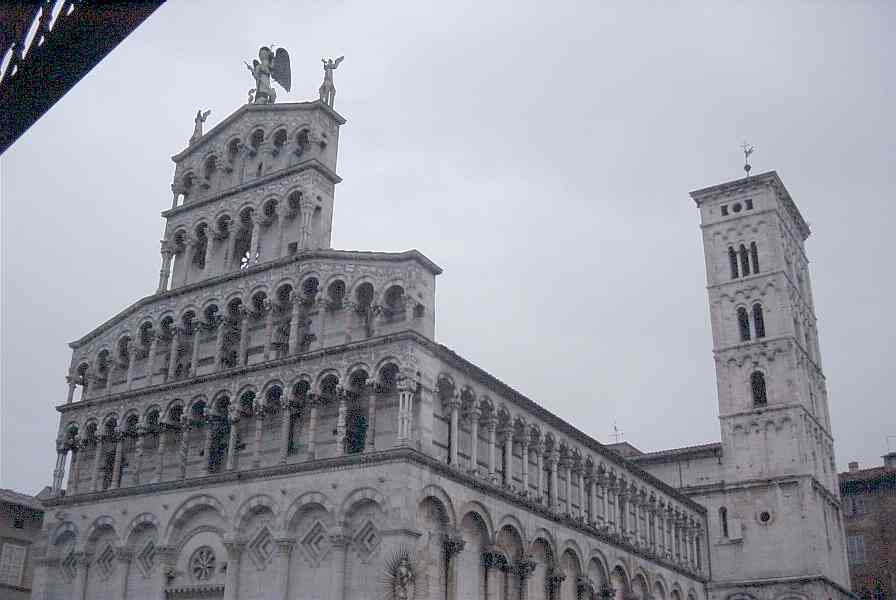
We found an open side door but, unfortunately, the exiting cleaning ladies wouldn't let us in. So we found a restaurant to get some warm Tuscan soup and then headed back to the Florence airport which we found after the requisite amount of circling.
Thanks for joining us. If you've come this far, you've suffered through over 100 pictures and 20 pages. Sorry that we got carried away but there is an awful lot to see in Tuscany both man made and natural and a lot of good things to put inside your body. (We revived our taste for Chianti Classical, on hold for 30 years since the days we first got married and would buy those pear-shaped bottles in baskets.) Someday we will go back and see the rest of this beautiful area. A couple of weeks later, we spent the weekend in Reims looking at Cathedrals and tasting Champagne. Please join us by clicking here.
Haven't had enough? How about a music quiz. Lucca is famous for two famous composers. Besides Puccini who else? Click here find out and to hear this Luccan duo's music.
Where do you want to go today? Here's a few choices:
